Astrology: A Vernal Equinox Point Time-Line
Definition: [Astrological Ages] Because of the Precession of the Earth, as the centuries pass the Vernal Equinox Point appears to move against the Celestial Sphere, and so appears against different stars. [In fact, because of the Precession of the Earth it is our Viewpoint of the stars from Earth which is changing with the centuries, not the stars themselves.] According to Jung, the astrological constellation which the Vernal Equinox Point can be seen against defines the Astrological Age.
|
A Vernal Equinox Point Time-Line: Vernal Equinox Point c 2600 AD [Age of Aquarius Begins]: In 2600 AD the Vernal Equinox Point is just on the border between the constellations of Pisces and Aquarius, i.e. that is where the Sun will be as viewed from Earth, on the Vernal Equinox in that year. Hence, this marks the Dawning of the Age of Aquarius according to Jung, if the date is calculated using the modern constellation boundary between Pisces and Aquarius. This date is very much disputed - with many different opinions for the beginning of a New Age. [See Age of Aquarius for more details.] How to understand the Star Map The Sun is in yellow in the center of the map. The white line is the Celestial Equator; the red line is the Ecliptic. The Constellation borders are shown in green; the lines representing the Constellation's figure are shown in white; Constellation names are shown in yellow. Individual stars are coloured white and their names are shown in red. Planets are marked by their astrological symbols. Click on any star map to see a larger version. |
 |
|
Vernal Equinox Point 2000 AD [Age of Pisces]: Currently, the Vernal Equinox Point lies in the constellation of Pisces. Hence, we are living in the Astrological Age of Pisces, according to Jung. Some astrologers dispute this and state that we are currently living in the New Age. It was only in the century preceeding 2000 AD that the concept of an Astrological Age became important in astrology. Though as early as 150 BC it was apparent to astrologers that the Vernal Equinox Point moved, astrology was not discussed in terms of Ages until the work of Jung. Note: the star map is correct for the constellation and hence Real Solar Zodiac sign of Pisces. It is not connected with the so-called Tropical Zodiac sign of Pisces. |
 |
|
Vernal Equinox Point 1540 AD: In the middle ages, the Vernal Equinox Point was in the constellation of Pisces. By the 1500s the Vernal Equinox Point was closer to the start of Pisces than to the start of Aries, meaning that we astrologers should really have made Pisces the first Zodiac Sign in our system, but over four hundred years later we have yet to do so. With the rediscovery of Classical astrology by Europeans in the middle ages the concept of a Tropical Zodiac became fixed in astrologers minds, and the fact that the Sun was in Pisces at the Vernal Equinox Point seems not to have been considered relevant. In 1543 the astrologer Nicolaus Copernicus [Mikolaj Kopernik] [1473 - 1543 AD] published De Revolutionibus Orbium Coelestium, in which he showed for the first time [in Book iii Chapters 1 - 12] that the Movement of the Vernal Equinox Point was because of the Precession of the Earth. Previously astrologers had held that it was related to the movement of the stars. |
 |
|
Vernal Equinox Point 1030 AD: At the turn of the first millennium AD, the Vernal Equinox Point was in the constellation of Pisces. Western Europe at the time was dominated by the Christian faith, which considered Astrology as heresy, because its concentration on the divination of the future implied that the fates of men and women were predetermined. This conflicted with the Christain belief in free will. However, the Classical inheritance of astrology was being kept alive in Arabic culture. In 1029 AD, Al-Biruni produced the most famous book of Arab astrology, the Book of Instructions in the Elements of the Art of Astrology. |
 |
|
Vernal Equinox Point 150 AD: By 150 AD, the
Vernal Equinox Point lay
between the first and second fish of Pisces. At about this time Claudius
Ptolemy wrote the masterwork of astrology,
Tetrabiblos
[c 130 - 170 AD]. In it he ignored the even older Babylonian systems, but went
back to the system of Hipparchos stating: |
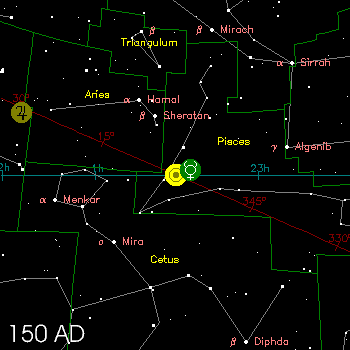 |
|
Vernal Equinox Point 1 AD: By 1 AD the
Vernal Equinox Point was
within Pisces. A decade later Marcus Manilius was writing the
Astronomica [c 10 - 20 AD], the first major treatise of astrology that
we still possess in its entirety. However, it is clear from Manilius work that
even though the Vernal Equinox
Point was now in reality in Pisces the astrologers of the time were still
using the older astrological systems. Concerning where the
Vernal Equinox Point lies
in Aries, Manilius writes: |
 |
|
Vernal Equinox Point c 90 BC: The Vernal Equinox Point lay on the border of the constellations of Aries and Pisces. Hence, according to Jung, 90 BC would have marked the end of the Age of Aries and the start of the Age of Pisces. Astrologers at the time would not have seen it in those terms, not having the concept of the Astrological Age. However, not long before this date the famous astrologer Hipparchos [c 190 to 120 BC] wrote On the Change in Position of the Solstitial and Equinoctial Points, the first account we know of of the observation of the movement of the Vernal Equinox Point. This work is now lost to us, but Hipparchos seems to have noted - correctly - that the start of Aries was now at the Vernal Equinox Point. He was essentially ignored by other astrologers who incorrectly continued to use the older Kidinnu and Nabu-rimanni systems for relating the Vernal Equinox Point to the start of Aries. |
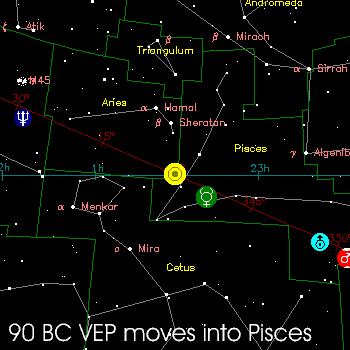 |
|
By 375 BC the Equal-Sign Zodiac. was becoming established. However, the Vernal Equinox Point was steadily moving, which meant that astrologers needed to re-define their system against it. This lead to what is now called System B [attributed to the Babylonian astrologer Kidinnu c 400 - 310 BC] in which the start of Aries lay at 8º from the Vernal Equinox Point. For a while both these systems were in use by astrologers in the Classical world. We don't really know whether it was yet understood by astrologers that the Vernal Equinox Point was moving, or whether later astrologers simply thought that their predecessors work was innaccurate. |
 |
|
At sometime, not long after 500 BC the Babylonians developed the concepts of both a personal horoscope and and an Equal-Sign Zodiac. Over the next few hundred years the positions of the planets would cease being discussed relative to particular stars, and start to be placed in the horoscope relative to the Zodiac. The first Sign of this new system was what we now call Aries. However, the Babylonian astrologers were well aware that the start of Aries did not exactly coincide with the Vernal Equinox Point. In what we now call System A [attributed to the astrologer, Nabu-rimanni, c 560 to 480 BC], the start of Aries was 10º from the start of the Vernal Equinox Point. The star map shown right uses the modern Aries-Pisces constellation boundary, but from Nabu-rimanni this must be very close to the boundary that the Babylonian astrologers used. |
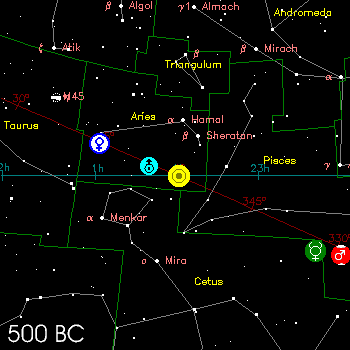 |
|
Vernal Equinox Point 1000 BC: By 1000 BC the Babylonians saw in the skies some 17 constellations along the Path of the Moon. However, their astrology had not yet developed what we would now consider as a Zodiac. The planets were described only in terms of their relationships to the stars or to other planets. They had yet to discover the concept of the Ecliptic, though they did have some concept of the Celestial Equator, as shown by their Paths of Anu, Ea and Enlil in the heavens. Astrology was dominated by Omen Astrology; horoscopic astrology had yet to be invented. Above all, the Omens of the Moon dominated Babylonian Astrological thought. |
 |
|
Vernal Equinox Point c 1875 BC: The Vernal Equinox Point lay on the border of the constellations of Taurus and Aries. Hence, according to Jung, 1875 BC would have marked the end of the Age of Taurus and the start of the Age of Aries. [This is using the modern constellation border, but in 1875 BC there was not yet the concept of a constellation border, so there is little choice but to use the modern one.] Babylonian astrologers of the time would not have realised this. Records of the movements of the stars and planets did not start until later in their history, and they had yet to invent the concept of the Ecliptic, though they may already have begun to think of a Path of the Moon through the heavens. Perhaps Egyptian astrologers were aware of the movement of the Vernal Equinox Point - though almost certainly not in those terms - because of the importance of the stellar alignments of buildings in their religion. However, Aries and Taurus were not constellations in the Egyptian system, which by 1500 BC consisted of 36 of what we now call decans, each with its own asterism, a small group of marking stars. |
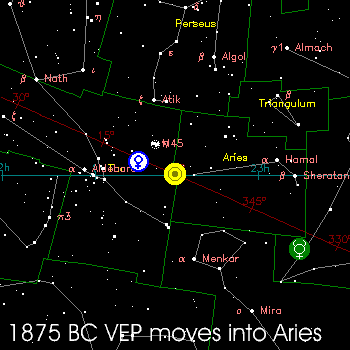 |
|
Vernal Equinox Point 4000 BC: Whilst mankind would have been fascinated by the stars, neither Zodiac nor horoscopic astrology had yet developed. It is, however, possible that some sort of Omen Astrology had already begun: that mankind had seen events on Earth and begun to link them with events in the skies, like eclipses. If they did, we know nothing of it; writing had yet to be invented. Note: - Time Line Assumption This time line for the Movement of the Vernal Equinox point assumes that the rate of the Precession of the Earth's axis hasn't varied over the last six thousand years. We astrologers have no way of proving this. However, the maps based on a contant rate of precession seem to tie nicely with the work of the astrologers Nabu-rimanni, Kidinnu, and Hipparchos as shown above. Click on any star map to see a larger version. |
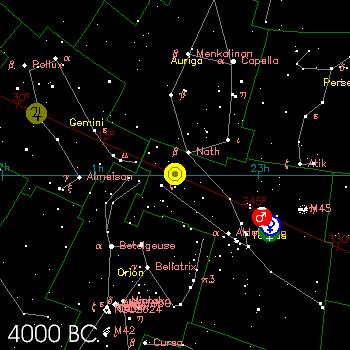 |
Key Concepts...
| 2: | Key Concepts... |
| 2a: | Precession of the Earth |
| 2b: | Nutation of the Earth |
| 2c: | Movement of the Vernal Equinox Point |
| 2d: | Precession of the Equinoxes |
| 2e: | The Changing Pole Star |
© Dr Shepherd Simpson, Astrological Historian
Historical Astrology
See the new Astrological Index for the meaning of other astrological words and phrases